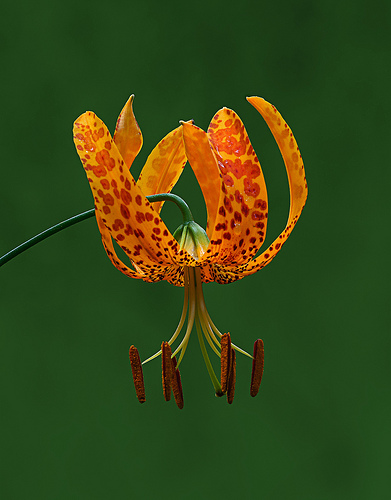“My cannas leaves seem to be having a problem opening and I’ve noticed that some of them have a rather sticky kind of stringy substance across them. Not all the leaves are this way as some of the plants in other parts of my yard are looking very good, while others are not. What could be causing this?”
Don and June
Buckhannon, West Virginia
Don and June:
The leaf roller is about the only thing that bothers cannas. It’s actually a caterpillar that comes from the skipper moth and prefers to lay her eggs inside young cannas leaves, sewing them shut with that “stringy substance” to protect their larvae. Once they hatch they will then start feeding on the actual cannas leaves. You’ll want to gently unfold those young leaves where you can see they are being hindered and you’ll find the pests inside. When I can, I flip them the pests off into the yard where a bird can pick them up for a snack, but if you have a lot of cannas you’ll want to find an insecticide specifically for worm or caterpillars eradication. If you have leaves that are heavily damaged, remove them and throw in the garbage, not in your compost pile.
Another note: After the frost completely kills the plants, remove all the foliage and bag and dispose of them separately so you don’t risk the chance of them over wintering and affecting next year’s plants. This is particularly important in southern zones where cannas are perennials, as opposed to annuals in the northern climates.
Ask Monty’s:
“Every year I am amazed that my clematis comes up. They’re never spectacular, but they do put forth the effort to flower. I know they like their “heads in the sun and their feet in the shade” and I have them planted appropriately so. My problem is that this summer – mid July – the leaves are already starting to turn brown. Isn’t it a little early for that?
Gayle
Brilliion, Wisconsin
Gayle:
Browning of the leaves is pretty normal particularly after the heat of the summer and once the plant is done blooming. Not too nice to look at, but you can safely prune away the dead leaves and continue to keep the plant well watered and well mulched to keep in the moisture. If the plants are just beginning to brown, and you are set on reviving them, try applying Monty’s Liquid Carbon to the soil to improve moisture flow into the root zone and to reduce compaction which will allow the roots to spread out and access more moisture and nutrients. Also start a foliar program with Monty’s 2-15-15.
If you follow the advice here on our blog you may be wondering why I am recommending the 2-15-15 formula during a ‘growth time’ in the plant’s development cycle. The reason is your plants are showing signs of stress from heat and drought. The last thing we want to do is to encourage MORE top-growth when the plant can’t support what it has now. So by applying the 2-15-15 formula you are signaling the plant to put its energy into developing roots; kinda babying it until it recovers. The plant is also about done for the season, so let’s help it store energy to get through the winter ahead, a high dose of nitrogen right now could keep it from entering dormancy normally and expose the plant to more winter-kill.
If the brown leaves or wilt extends to the actual growing tip and the vine itself becomes brittle or turns almost black, the vine is probably dead as well. Prune the vine down to the closest living branch area so all the dead material is done away with. Again, if you keep the plant well watered and fed you may continue to see new growth as the summer progresses.
Ask Monty’s:
“I have heard that adding salt to your asparagus beds is supposed to help them. I have a beautiful wild asparagus bed and would sure like to maintain it as best as I can. Is there any truth to the salt advice? Is it just table salt?”
Roland
Crossgate, Kentucky
Roland:
Some people will add sodium chloride rock salt (NaCI) to their asparagus beds after they are at least a year old. It sounds like your wild bed is already well established – so you can do this. Apply about two and half pounds per 100 feet either before the spears actually appear in the spring or around July 4 when you’ve already pretty well harvested your crop. The salt prevents crown and root rot diseases caused by fusarium fungus and actual improves the plants overall growth. Do not use iodized salt (your common table salt) or rock salt made of calcium chloride (CaCI). Pickling salt is fine too.
If the thought of adding salt to your plants just sounds to chancey, you may consider using Monty’s Liquid Carbon in the spring and fall. Crown rot and fusarium are what we like to call ‘wet feet’ diseases. That is, they tend to move in when the roots of the plants are kept excessively moist, either from a wet spring or from over watering. In Kentucky, most gardeners deal with fairly heavy clay soils, so the moisture you receive tends to hang around. By applying Monty’s Liquid Carbon, you can change the structure of these soils so that they allow the moisture to move more freely through the soil profile which results in better drainage. Once your drainage situation is under control you will likely see a marked decrease in many of these ‘wet feet’ diseases.







 s on this plane.
s on this plane.